How To Grow Your App Through Content Marketing
Most apps rely on Facebook and Google for growth. In recent years, content marketing has become the next level in the marketing mix.
Every app is dreading the day that Facebook becomes too expensive, or when Google makes one of their products obsolete.
To prepare for this uncertain future, mobile marketers are constantly testing new channels. They put their efforts into other social media channels, affiliate marketing, and even offline advertising for more breathing space.
A few apps have gone beyond that and discovered the scalability of content marketing.

What is content marketing?
Content marketing refers to driving growth through a blog. Traditionally, this is done through organic means, such as SEO, or social sharing. In the past few years, blogs have proven to be a great tool for paid advertising as well. In fact, the latter can effectively drive conversions for apps, when used in the right way.
Before going into that, I’d like to introduce you to two more protagonists in this story, the native advertising platforms Outbrain and Taboola. Around a decade ago, the founders of these companies caught on that online newspapers were struggling to monetize, and didn’t want to rely on selling ad space to Google. They offered these brands a better alternative — to sell ad space to other publishers. This led to the birth of the “From around the web” section that appears at the end of every article on most websites.
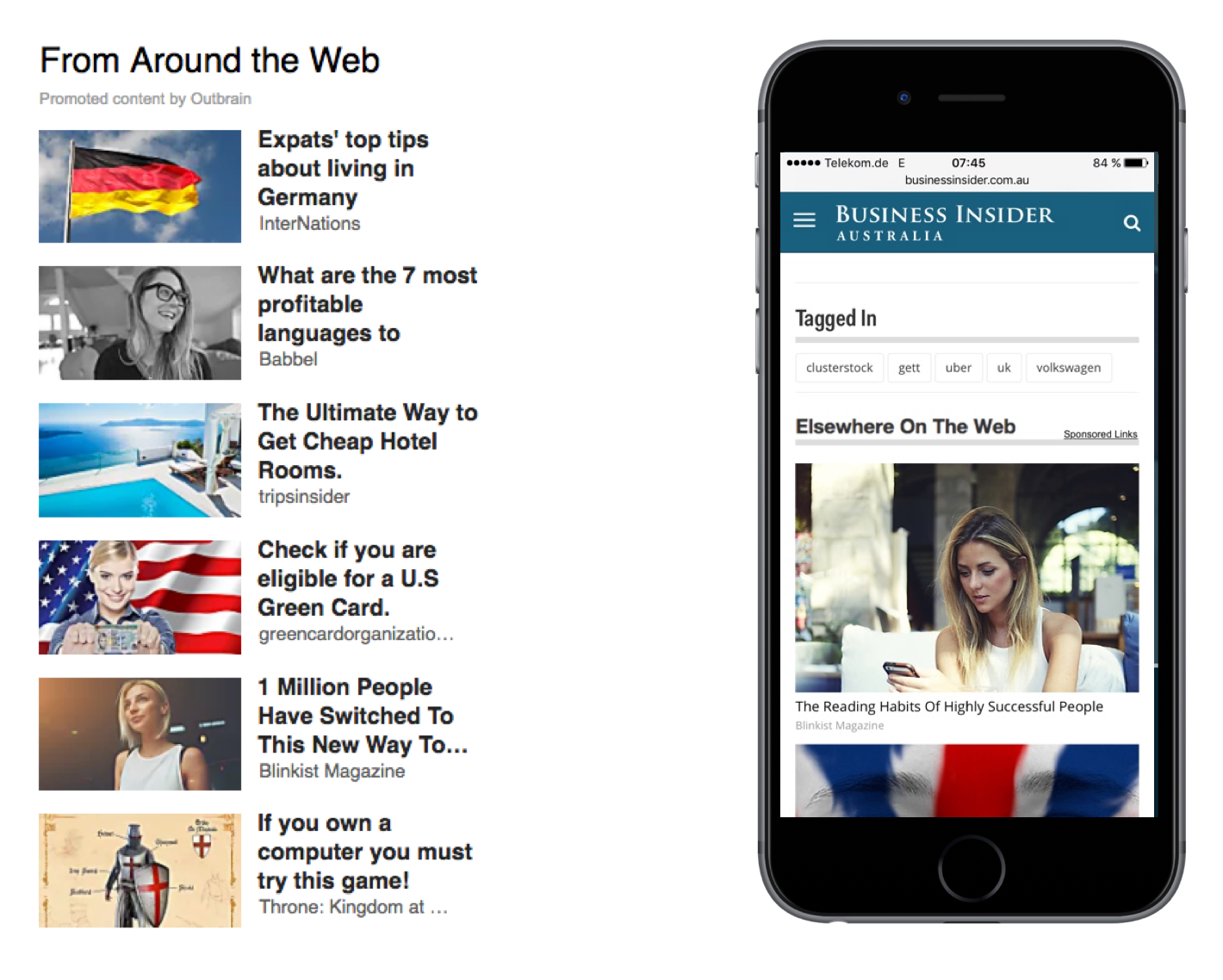
Like every novel thing, this new type of advertising has been met with skepticism. From my experience, based on the power of this platform, this skepticism will disappear with time. Both Outbrain and Taboola are actively improving the quality of their inventory to fulfil their mission — to allow consumers to discover valuable content.
Ed Wood, previously the content marketing wizard at Babbel, was the first one to make native advertising work for apps.
Content vs. ads
Everyone runs mobile app install ads. What if you advertised an article instead and informed the reader about the product before driving them to the app store?
This might seem counterintuitive, why would you create an extra funnel where you can lose people?
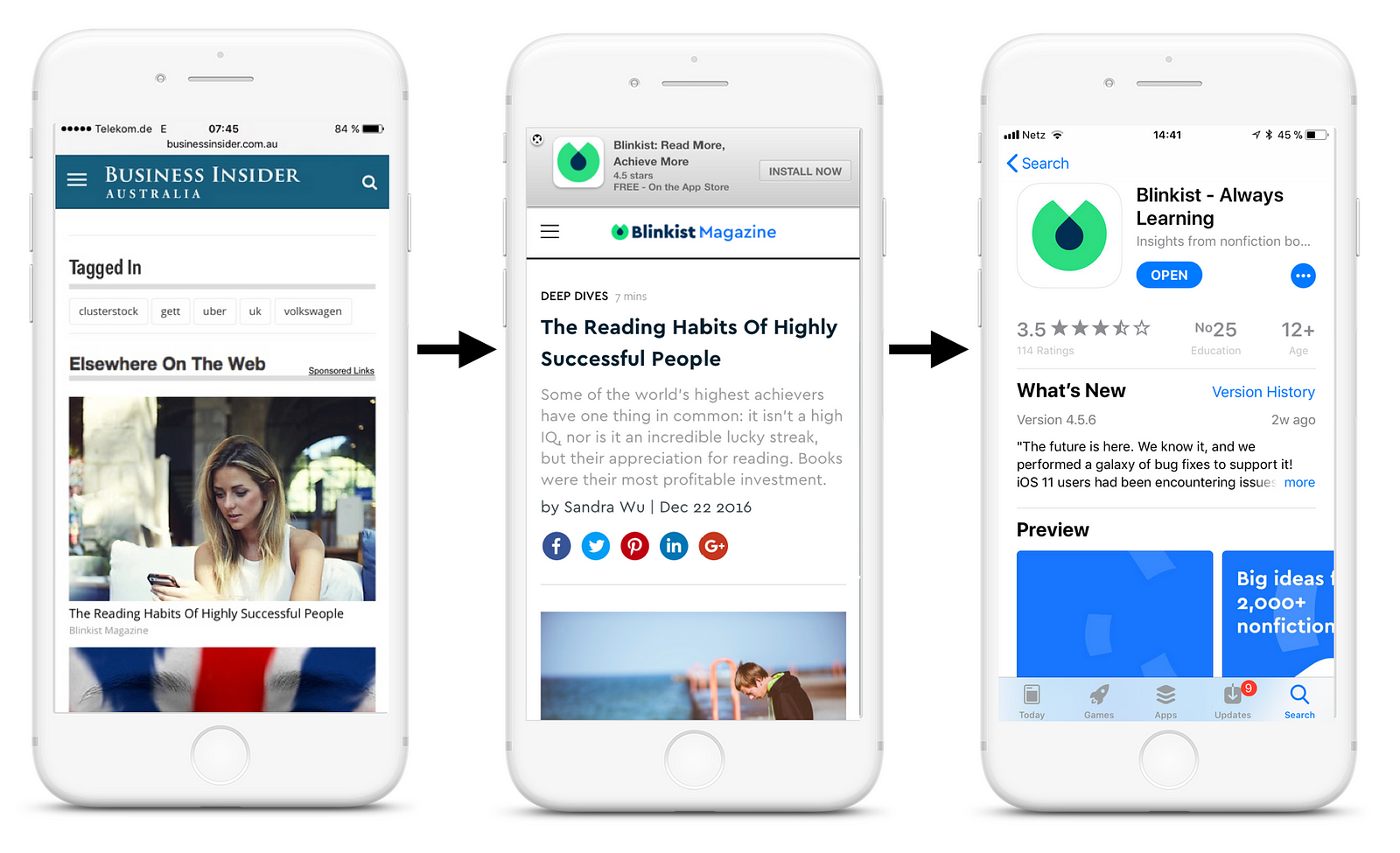
This is where the magic happens: people are a lot more likely to click on an article than an ad. And once they’ve read a few hundred words about your app, they’re more willing to try it out, renew their subscription, and spread the word.
How do you sell an app through content?
The more abstract your app is, the more you can benefit from content marketing.
Take Blinkist for example. We’re a reading app that condenses key insights from nonfiction books into quick reads and listens. Most people wouldn’t even know such a product exists, let alone understand why we built it. With Facebook, we get to explain ourselves in two sentences. With content marketing, we get to share our mission in detail — we offer quick insights from books, so people can learn faster and become better versions of themselves.
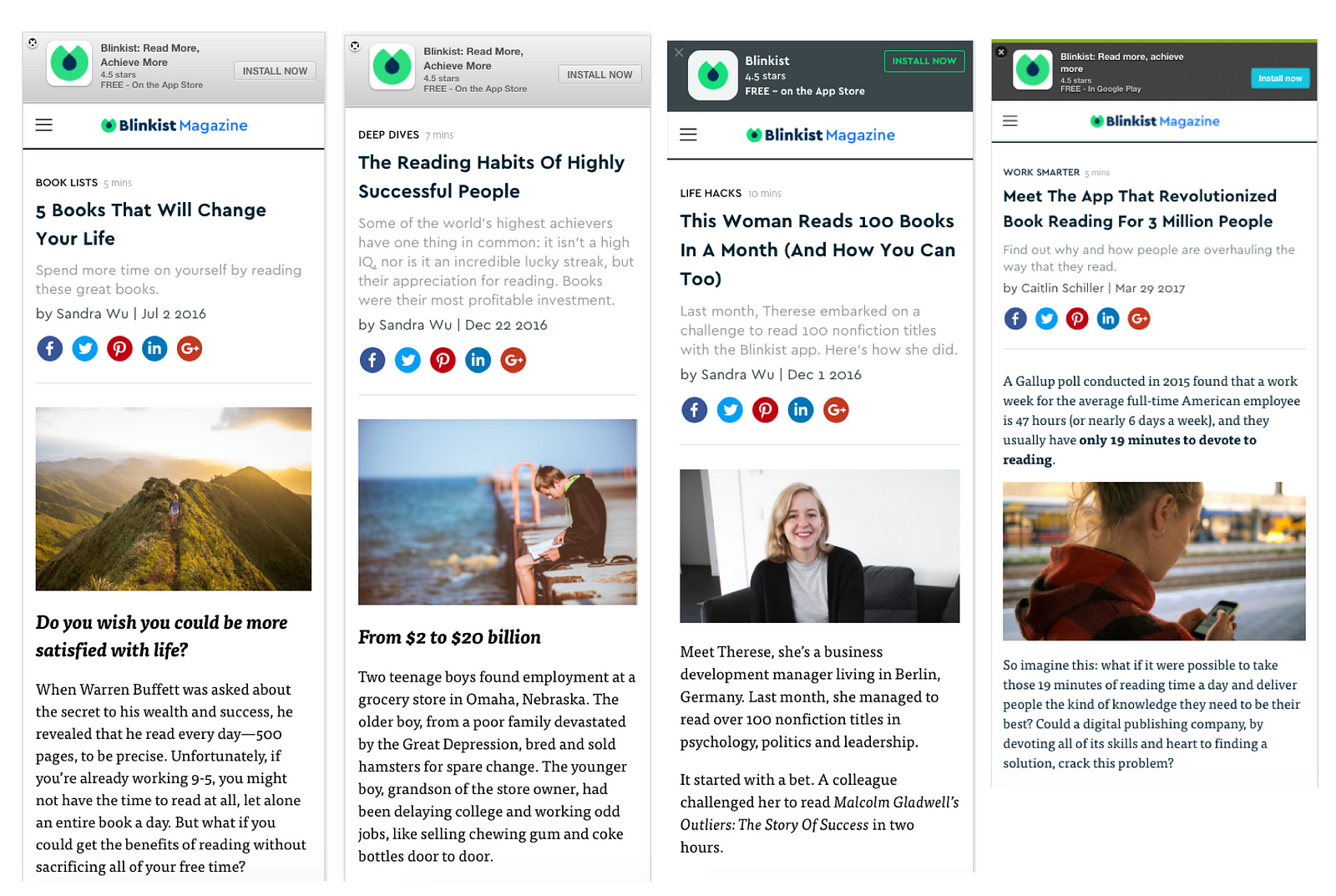
Content marketing is also important to us from a branding perspective. For example, our paid articles live on our magazine, which has great content on self-improvement. Once we drive people there through Outbrain and Taboola, they also stick around and explore the rest of our magazine.
In the end, we succeed in branding Blinkist as more than just a reading app, but a powerful tool for anyone who wants to improve themselves.
Getting the content right
Recently, a lot of apps are testing content marketing. A few succeed, but most fail. This all comes down to getting the content right.
With app install ads, you only need to say a few words about your app. The banner image, carousels and videos do most of the heavy lifting. In content marketing, you have to write an article that people are interested in, that has a strong connection to your product, and explains its value proposition.
Most apps use the wrong articles, which either do not have a strong connection to their product, or aren’t appealing to the general public.
In addition, unlike social media channels, Outbrain and Taboola doesn’t allow you to target beyond device and country. This limitation is actually a blessing in disguise, as it forces you to create content that attracts the right people.
If you want to make content marketing work for your app, spend time on getting the content right before launching the first campaign.
Content marketing is mostly common sense
I’ll share with you three A/B tests that taught us one important thing — content marketing might seem difficult, but most of it is common sense.
1. Use the title to set expectations
Performance marketers tend to be obsessed with high click-through-rates (CTR). This approach is lethal in content marketing. You don’t want everyone who reads the news to click on your ad when you pay on a CPC basis.
In the following example, we launched an article around a reading challenge titled “[Watch] What You Can Learn From The World’s Best Nonfiction Books In 15 Minutes”. While this title had a high CTR, we also saw a high bounce rate as people were not expecting an app. Subsequently, we relaunched this campaign with the title “[Watch] All The World’s Best Nonfiction Books In One App”. By doing so, the CTR dropped by 20% as expected, but the signup rate doubled.
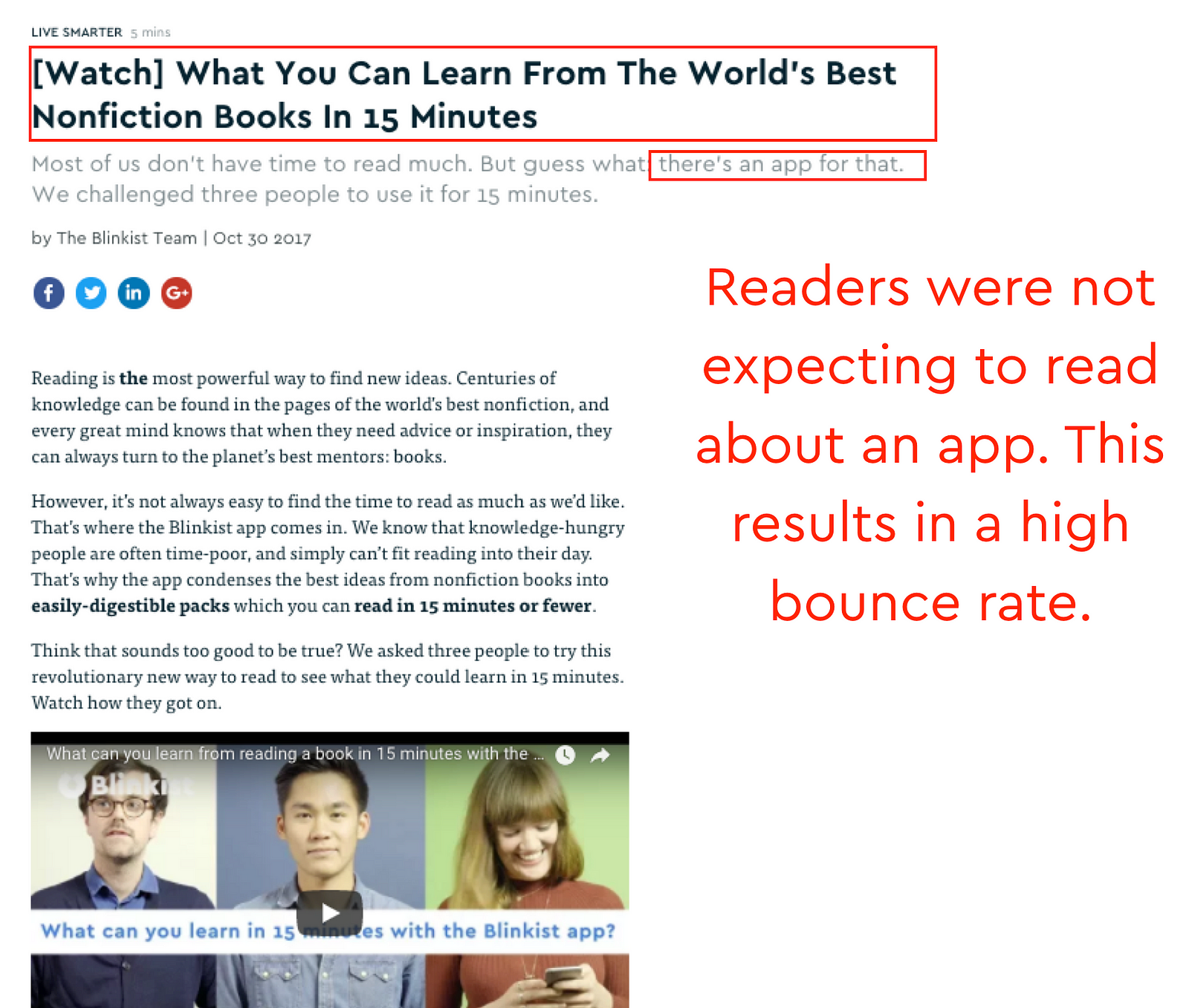
The lesson was clear — you wouldn’t tell someone you sold fruits in your shop when you only had bananas, so why would you do it with an article?
2. The intro is the most important part
Whenever we run A/B tests, we always focus on the section above the fold (what the reader sees without scrolling). Why? You have about 30 seconds to convince the reader to not bounce, and those first two sentences make all the difference.
In the below article “Meet The App That Transformed Reading For 1.5 Million People” (now 4 million), we referenced several studies before introducing the app. While it’s good to ease people in, we’re dealing with an audience who want to know more about this fabled app from the ad. We A/B tested another version that mentioned just one study, and found a 13.41% increase in signup conversion.
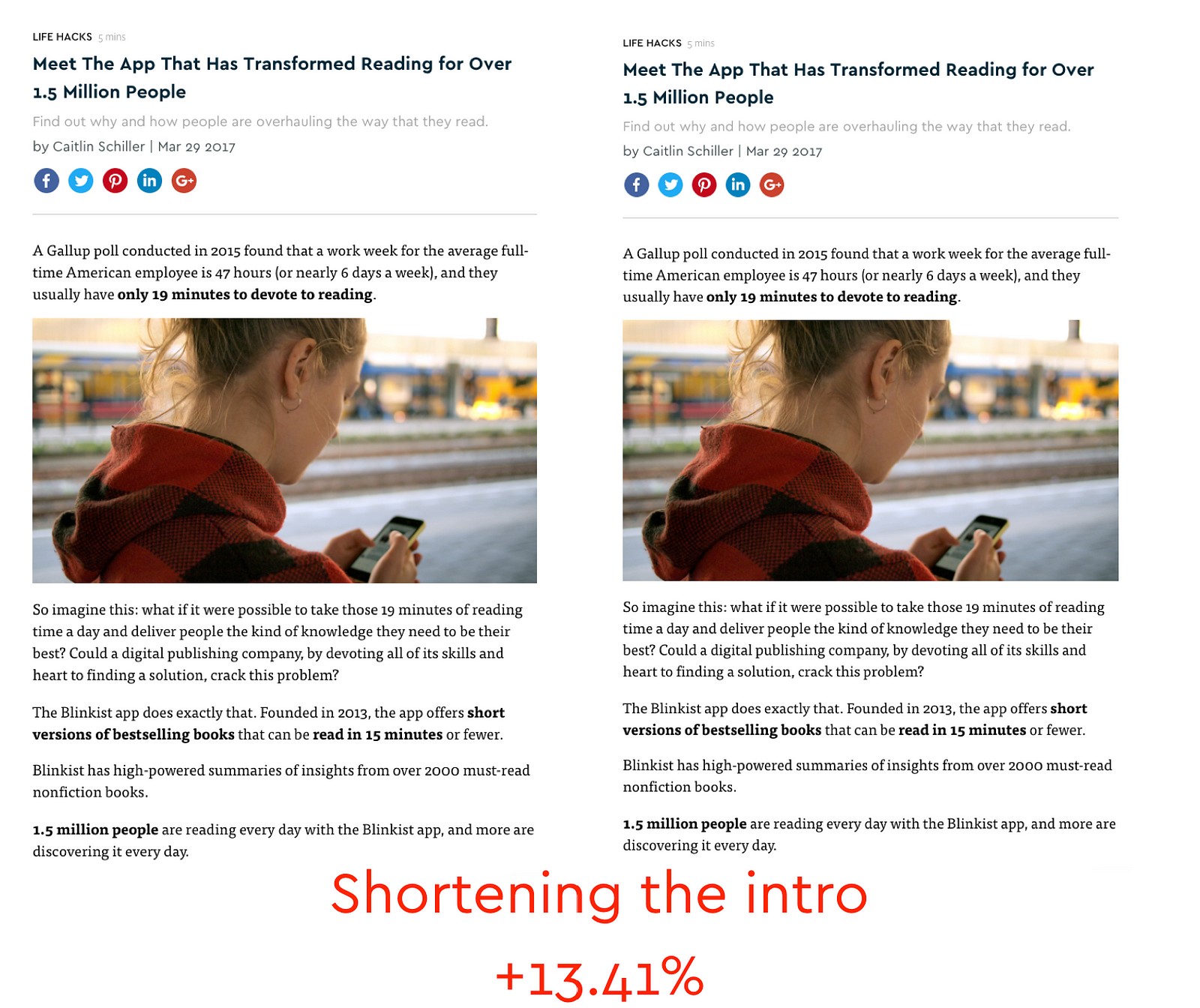
This also made sense — once you’ve hooked people in, give them what you promised.
3. Mention your product in the beginning
There’s always a debate on when the product should be mentioned. Should we do it right away and risk turning the reader off? Or wait till the very end when we’ve already lost some people? We don’t have a definitive answer as we’ve found success with both, but 80% of the time, the former works better.
Let’s look at this list of self-improvement books below. Before introducing the books, we have to explain what our product does so the reader know what to do with the books. This might seem a bit aggressive, but was proven to be 39% better for signup conversion.
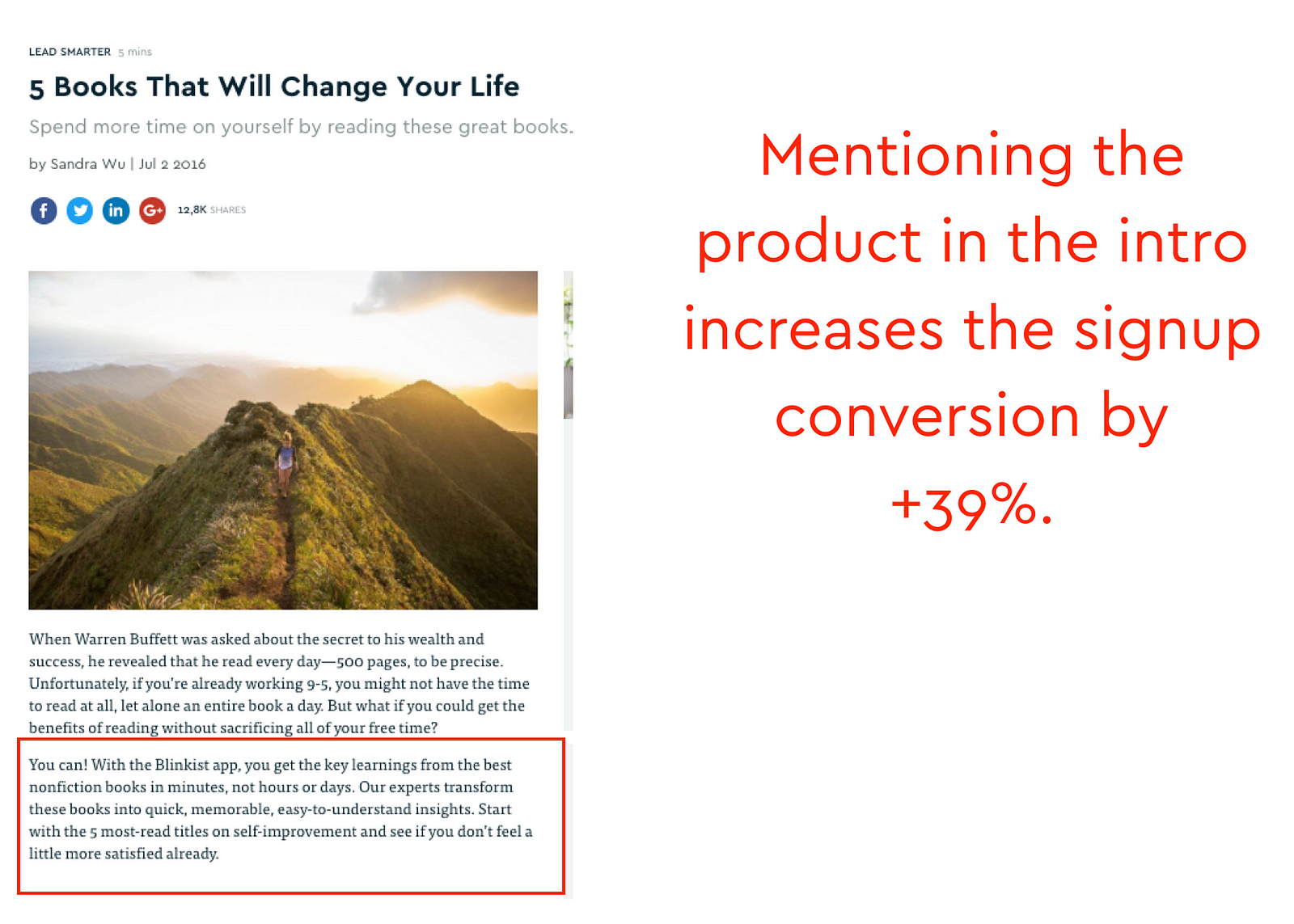
This goes back to the idea of setting expectations — don’t drag out a conversation when you clearly want something, mention it right away.
I hope I made content marketing seem less daunting. For the brave ones, carry on reading!
How to get started
The main thing you need to know is that you won’t be able to scale this channel overnight. There are some apps that find success instantly, but they are the exception, not the rule.
The first few months will be hard. You have to figure out the right content, justify resources, make your blog conversion-driven, etc. But if you invest in the resources and time to do so, content marketing could become your most powerful growth strategy.
The first question you might have is which channelyou should work with. Both Outbrain and Taboola offer similar products (although the companies could not be more different). Your biggest concern should be which publishers they work with (e.g. CNN, MSN, etc.). Have a look at their portfolios and decide which one would work better for your app.
I would always recommend getting an account manager who can walk you through everything. However, that entails committing to a minimum budget (a few thousand) at the start. In case you need to see some numbers beforehand, you can create a self-serve account.
You’ll also need a conversion-driven blog. This means that it should make people sign up for your app after reading an article. Medium posts will not cut it as there are too many calls-to-action. You can either create a blog from scratch, or a standalone landing page.
Once you have an account and blog set up, take the first weeks to figure out what content to promote. Don’t reuse what you already have. Sit together with your team and figure out what you want the rest of the world to know about your app. Refer to the previous section “Getting the content right” for best practices.
When it comes to content writing, the rule of thumb is that it should be done in-house by people who really understand the product, not a freelancer who’s never set foot in the office.
I also recommend reading Brax’s blog on campaign setup. They’re a management tool for native advertising (similar to Smartly for Facebook), and keep a very informative and current blog on launching campaigns.
To attribute everything correctly, you just need to have the right utm structure. You can also dynamically pass utm parameters onto adjust/appsflyer links within the article (e.g utm_term=BBC+News turns into adjust.com/xx?adgroup=BBC+News). I’ll leave it to Brax to explain this part better.
To get the highest ad engagement, use images of people and a short headline. The title should be as clear as possible — if it doesn’t sound natural in a conversation, don’t use it here. As an example, see below:
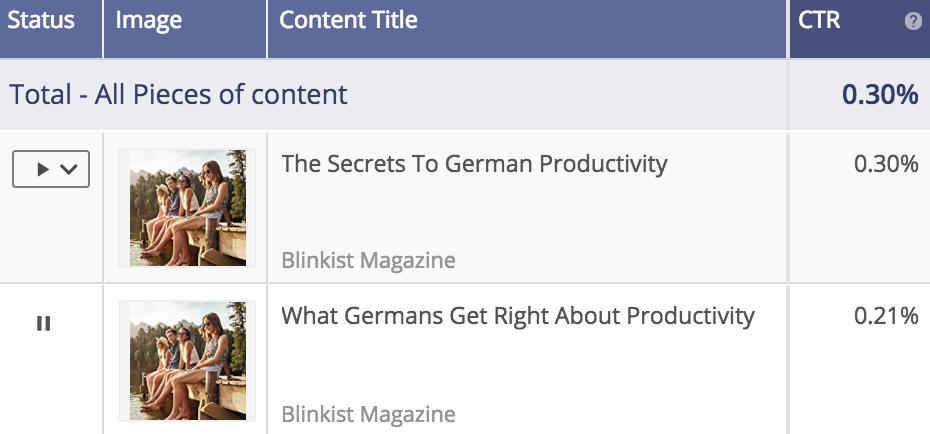
As for team structure, don’t hire a team right away to take care of this channel. Run the initial test with the resources you have on hand, and only consider additional personnel if you can make this channel sustainable.
Regarding how to measure success, we evaluate our performance based on return-on-investment. The ideal model would take into account organic uplift, lifetime value and brand impact. But you need to measure this for your product before applying it as a default.
That’s all you need to know to get started. Ready to convert your users through content?
Do you know other channels that are as scalable as content marketing? Let us know in the comments below! We would love to exchange best practices
This content was originally published here.
